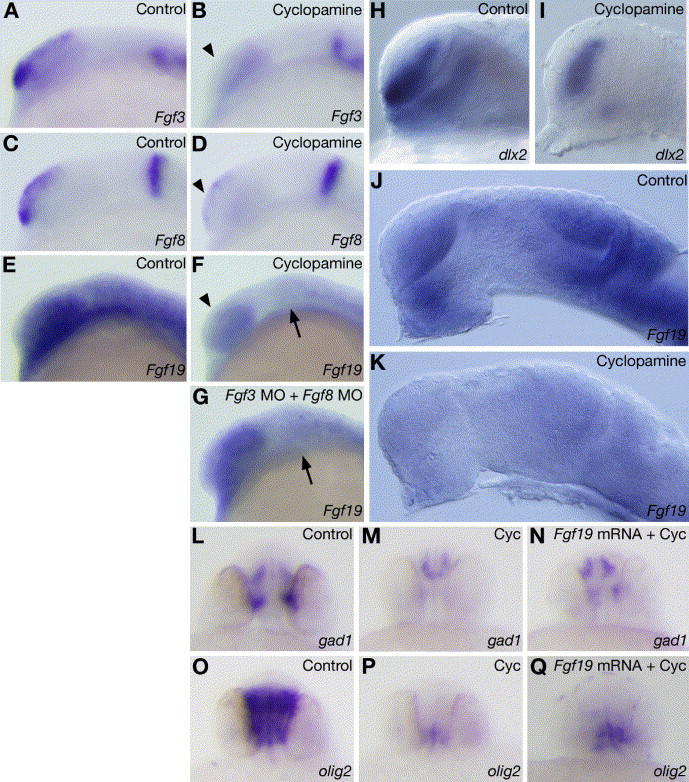Fig. 9
Fig. 9 Regulation of Fgf19, Fgf3 and Fgf8 by Hh signaling. (A–D) Expression of Fgf3 (A and B) and Fgf8 (C and D) in embryos treated with 0 μM (A and C) or 100 μM (B and D) cyclopamine at 15 hpf. The treatment of wild-type embryos with 100 μM cyclopamine did not affect Fgf3 and Fgf8 expression in the MHB, while the expression of Fgf3 and Fgf8 in the telencephalon (arrows) was markedly reduced. (E–G) Fgf19 expression in wild-type embryos (E), embryos treated with 100 μM cyclopamine (F) and embryos injected with Fgf3 MO and Fgf8 MO (G) at 15 hpf. (F) Fgf19 expression in the cyclopamine-treated embryos was reduced in the forebrain (arrowhead), midbrain (arrow) and cerebellum. (G) In the embryos injected with both Fgf3 MO and Fgf8 MO, Fgf19 expression in the forebrain was unaffected, while that in the midbrain (arrow) decreased. (H–K) Expression of dlx2 (H and I) and Fgf19 (J and K) in embryos treated with 0 μM (H and J) or 100 μM (I and K) cyclopamine at 25 hpf. (H and I) The treatment of wild-type embryos with 100 μM cyclopamine strongly reduced dlx2 expression in the ventral thalamus. (J and K) Fgf19 was normally expressed in the control embryos (J), while Fgf19 expression in the cyclopamine-treated embryos was extremely reduced in the forebrain, midbrain and cerebellum (K). Lateral views with anterior to the left and dorsal to the top. (L and M) Expression of gad1 in embryos treated with 0 μM (L) or 50 μM (M) cyclopamine. The treatment of wild-type embryos with 50 μM cyclopamine strongly reduced gad1 expression in the telencephalon and lost gad1 expression in the diencephalon at 28 hpf. (N) Expression of gad1 in embryos injected with Fgf19 mRNA and treated with 50 μM cyclopamine. The expression of gad1 in the telencephalon and diencephalon was rescued by injection of Fgf19 mRNA at 28 hpf. (O and P) Expression of olig2 in embryos treated with 0 μM (O) or 50 μM (P) cyclopamine. The treatment of wild-type embryos with 50 μM cyclopamine strongly reduced olig2 expression in the forebrain at 28 hpf. (Q) Expression of olig2 in embryos injected with Fgf19 mRNA and treated with 50 μM cyclopamine. The expression of olig2 in the forebrain was rescued by injection of Fgf19 mRNA at 28 hpf. Frontal views with dorsal to the top.
Reprinted from Developmental Biology, 288(1), Miyake, A., Nakayama, Y., Konishi, M., and Itoh, N., Fgf19 regulated by Hh signaling is required for zebrafish forebrain development, 259-275, Copyright (2005) with permission from Elsevier. Full text @ Dev. Biol.

